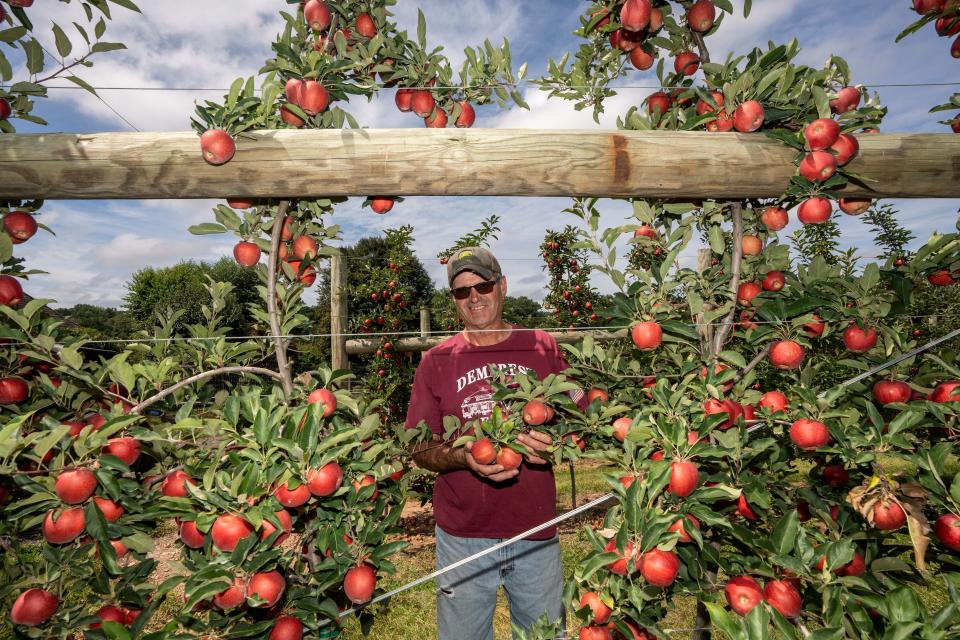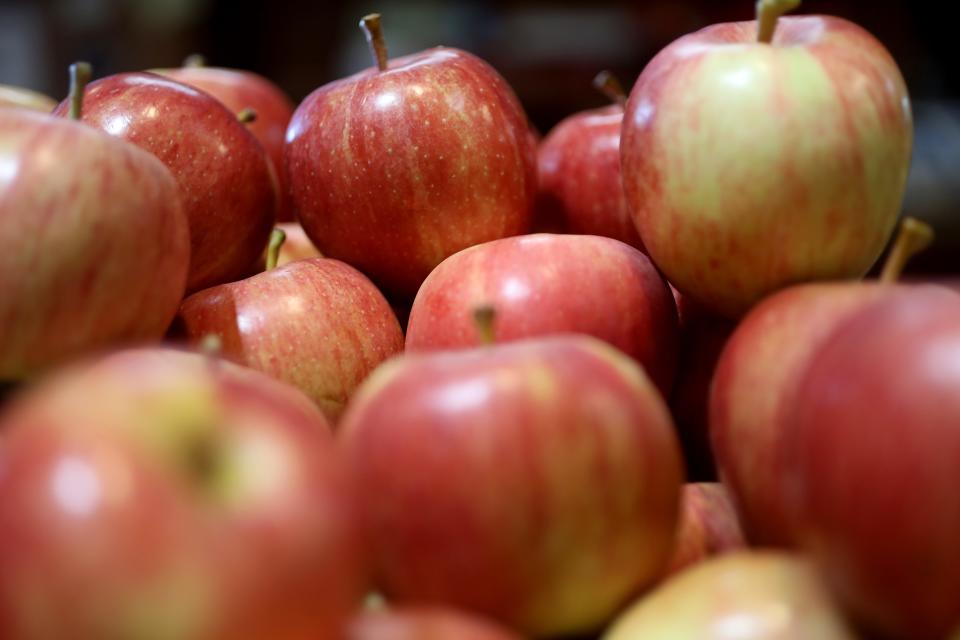There are 2,500 varieties of apples in the U.S. Here's why — and a guide to the best
What's the apple of your eye?
McIntosh? Macoun? Cortland? Honeycrisp? Jonagold? Golden Delicious? Autumn Crisp? Ludacrisp? Mutsu? Fuji? Rhode Island Greening? Granny Smith? Jonathan? Empire? Liberty? Freedom? Enterprise? Crimson Crisp? Stayman Winesap? Rome? Cameo? Pink Lady?
Don't get us started. Because believe me, we could go on.
"There are so many different flavors," said Jim Spollen, co-owner of Demarest Farms and Orchard in Hillsdale. They grow 24 varieties.

"It reaches across the whole spectrum," he said. "I don't think I've met anybody who doesn't like an apple."
Autumn days are apple days. The time when we all think about biting into a crisp, cool, delicious, doctor-discouraging apple. If not biting one, then bobbing for one. Or candying one. Or picking one with the kids. Or pulping one into cider or applesauce. Or baking one into a pie, a brown betty, a pan dowdy, an apple crisp, or a yummy apple cider donut.
But which apple?
The choice is yours

There are 2,500 varieties of apples currently grown in the U.S. There are 7,500 worldwide. And that's nothing.
Before about 1900, when horticulturalists began to scientifically winnow the selection down to the best varieties, there were more like 14,000.
"Some of them were not under big production," said Joel Flagler, agricultural extension agent for Bergen County, and a professor in the department of agriculture and natural resources at Rutgers.
It was agronomists at Rutgers, Cornell and Purdue — Rutgers, especially — who began in the early 1900s to study, select, and steer the orchard industry toward the hardiest, highest-yielding, best-tasting varieties.
Which is why you no longer see the Streaked Pippin, the Sary Sinap, and the Nero (there is a nonprofit "Lost Apple Project" in the Pacific Northwest that aims to recover some of them).
"These apples were a mom and pop kind of thing, local, small scale," Flagler said. "It was people sharing seeds, people sharing cuttings. And then Rutgers came in and said 'Most of these are crap.' "
The apple varieties you find now, at your supermarket or local farm stand, are the best of the barrel — sweet, crisp, succulent. Or, if your tastes incline the the other way, tangy and tart. But in any case, grow-able and saleable: apples are, in 2023, a $99 billion a year industry in the U.S.
From small beginnings
Not bad for a country whose only native apple, when the first Europeans got here, was the crabapple.
"Apples were not native," Flagler said. "They came from central Asia, but they arrived in North America in the 1600s. We've had going on 400 years of experience with apples. We've really had a lot of time to try new techniques."
Apples come, and apples go. The Roxbury Russet, the first European-cultivated American apple, was a big hit in the Massachusetts Bay Colony circa 1650, but don't look for it at ShopRite.
The Rome had its day; now its fading. So, now, is the once-ubiquitous Red Delicious. A triumph of looks over flavor, the Red Delicious was gorgeous to see — no apple was ever redder — but bland and sometimes rather mealy, truth be told. Spollen stopped growing them last year. "No one's really asking for them," he said.
More: Where to pick your own apples this fall in New Jersey
Infinite variety
Apples are unique. They are to the fruit world what dogs are to animal kingdom — infinitely adaptable, putty in our meddling hands. Over the centuries, they've been bred in all sorts of forms, for all sorts of characteristics.
The trees themselves have been tinkered with. Most that you see in orchards today are the dwarf or semi-dwarf variety — no more than 10 feet tall — to allow for easy picking. Remember the old song "Don't Sit Under the Apple Tree"? Try it. These days, it's almost physically impossible.
"That was a huge quantum leap," Flagler said. "It made harvesting easy, pest management easy. It allowed them to abandon all those crazy ladders."
It's also allowed for that fun fall activity — great for families, lucrative for growers — of pick-'em-yourself apple gathering. Demarest Farms, founded in 1886, opens its trees (it has some 15,000, over 34 acres) to the public Wednesdays through Sundays from Labor Day till about Halloween. Many other orchards have similar arrangements.
From out of the garden
The apple is not only central to our season, it's central to our culture. "It came from the Garden of Eden, right?" Spollen said.
Possibly not. Biblical scholars say the Forbidden Fruit was likely a quince. But the apple figures in just about everything else: from proverbs to songs to fairy tales to British record labels to iPhones to early American crackpots who wear saucepans on their heads while dispensing seeds.
"People will always have this love affair with apples," Flagler said.
But how to choose? It's so easy to make a wrong decision — as Snow White discovered on that fatal afternoon when the dwarfs were out. Apples vary. So do people's tastes. So do the uses they're put to.
To help sort it all out, Spollen has helped us create a simple flow chart of some popular apple varieties.
These are the Colors of the Apple Spectrum, if you will. UltraSweet, at the top of the continuum. Then down through all the gradations of flavor, to InfraTart at the bottom.
For eating
∎ Honeycrisp. Supersweet, juicy, crunchy, crisp. An accidental strain out of Minnesota, this is the apple that took the world by storm after it first came on the market in 1991. Since then, everyone's been trying to grow them sweeter and crisper. "Honeycrunch has that real explosive crunch when you taste it," Spollen said. "It makes noise when you eat it."
∎ Fuji. Very sweet, crisp and — you guessed it — from Japan. "It's a nice large apple, one of the most popular ones," Spollen said.
∎ Gala. Sweet, and very grower friendly — which is why it's the world's most popular apple by volume. "It took over from Red Delicious," Spollen said. "It's the highest selling apple."
∎ Ludicrisp. Some have compared the taste to Juicy Fruit gum. Others — connoisseurs — say they taste pineapple or strawberry notes. "It's somewhat new, so it's still got to catch on," Spollen said. "It's a pretty funny name."
∎ Evercrisp. Also crunchy and sweet. "It's a new variety, but a lot of the farm stands have it now, and you're starting to see it more in grocery stores," Spollen said.
∎ Cameo. This one somewhat resembles a Red Delicious. Sweet, mild, firm, though not as crisp as the Ludacrisps and Evercrisps.
∎ Golden Delicious. Everyone's favorite yellow apple. Sweet, crisp, mild. And teacher loves them.
∎ Jonagold. A cross between Jonathan and Golden Delicious. Which means it's got the Golden's sweetness, and a touch of the Jonathan's tartness. Fittingly, it's got a bit of red, and a bit of yellow in its skin. "It's crisp and sweet, big and juicy," Spollen said. "It's been around since the late '60s, early '70s."
∎ Jonathan. Mildly tart. "It's not the tartness scale of the Granny Smith or the Winesap," Spollen said. "Those can make you pucker like a lemon."
∎ Stayman Winesap. These are crisp, hard, tangy. Apples with a kick. "Staymans have been around since revolutionary times," Spollen said. "They're an old apple, but people love them."
∎ Granny Smith. God did indeed make green apples — and He made them hard, crisp juicy and oh so tart. These are the Sour Patch Kids of apples. Thank Maria Ann Smith, the Australian who created the cultivar in 1868. "I guess she was somebody's mother," Spollen said.
For cooking
∎ Applesauce: try Golden Delicious, or Cortland. Two different sauces, for sure. "Cortlands have a slight kick, but they're more sweet than sour," Spollen said "The Cortland doesn't oxidize, it stays white. So the sauce gets a pink tinge."
∎ Apple pie: try a mix of Golden Delicious, Granny Smith. "You're better off doing a mix, you'll get a balance of flavor there."
∎ Candy apples: use Empire.
∎ Apple cider: try a blend of Golden Delicious and McIntosh. Or even Red Delicious. "Actually, Red Delicious are good in the blend," Spollen said.
Other apples that are good in cooking: Rome, Ida Red, Greening. Cooking apples are often the less sweet varieties. And there's a reason for that.
"For fresh eating, you want a higher sugar content," Spollen said. "But that doesn't work too good in a pie. When the heat gets to them, they can get soft and runny."
This article originally appeared on NorthJersey.com: Apple Guide: Best ways for cooking and eating apples

